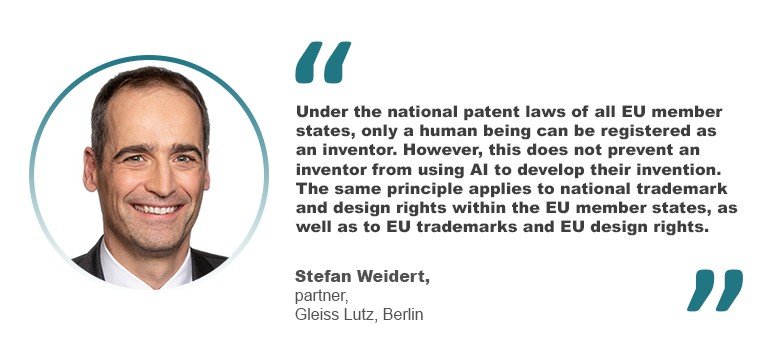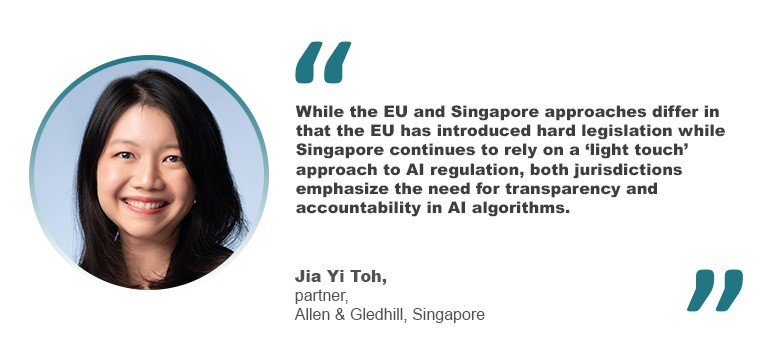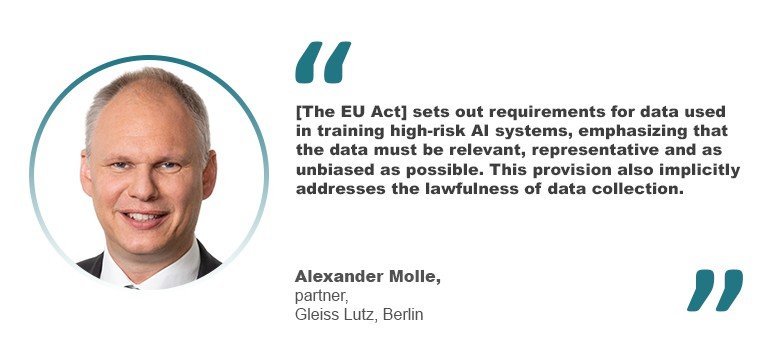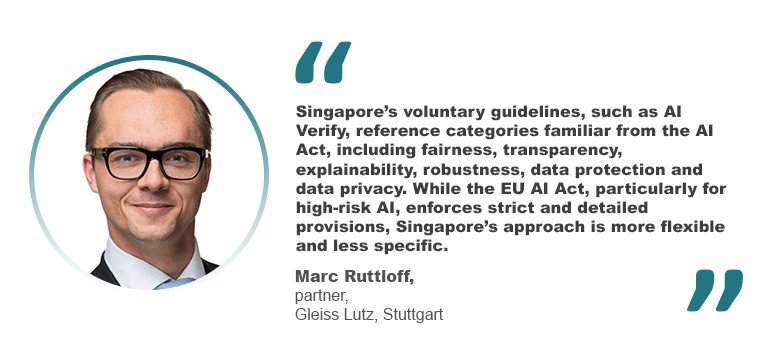Singapore, EU: A global perspective on AI regulation and IP rights
28 February 2025

How do Singapore and the EU’s IP strategies compare? Excel V. Dyquiangco discusses Singapore’s AI frameworks and the EU AI Act, addressing issues like copyright, patents and innovation ethics within the AI ecosystem.
Singapore and the European Union (EU) are global leaders in fostering innovation through robust regulatory frameworks and intellectual property systems. Singapore’s IP regime, known for its transparency and efficiency, attracts businesses seeking strong protection and commercialization opportunities in Asia. Meanwhile, the EU harmonizes IP laws across its member states, promoting fair competition and safeguarding innovation in its vast market.
Together, they set benchmarks for leveraging IP and regulation to drive economic growth and creativity worldwide, especially now with the widespread adoption of artificial intelligence and digital frameworks.
In terms of AI-specific regulation in Singapore, Jia Yi Toh, a partner at Allen & Gledhill in Singapore, said that the government adopts a ‘light-touch’ approach to AI regulation, with regulatory bodies introducing and working with the industry to promote the adoption of voluntary frameworks such as the Model AI Governance Framework and more recently, the Model AI Governance Framework for Generative AI.
“These voluntary frameworks do not, however, address the substantive question of whether IP rights can subsist in AI-generated works, which will still need to be determined under Singapore’s existing legal framework,” she said. “The question of whether IP rights like copyright and patent rights can subsist in fully AI-generated works has yet to be expressly addressed in legislation or by Singapore courts. We could look to past decisions of Singapore courts for some hint of the possible approach – for example, it has been held in a past decision of our High Court that an ‘inventor’ for the purpose of our patents act must be a natural person, in the context of determining whether a company could be an inventor. However, such decisions were not made in the context of AI and must be approached with caution.”
She continued: “In contrast, if the works are merely AI-assisted (rather than fully AI-generated), it is more likely that IP rights can still subsist in the works given the presence of human involvement or contribution. Therefore, businesses using AI to create works should ensure some level of human involvement or contribution to ensure these works (especially works which are key assets) enjoy IP protection and ensure that proper records are kept of such human involvement or contribution.”
In the EU, it does not address the application of intellectual property rights to AI-generated works. According to Stefan Weidert, a partner at Gleiss Lutz in Berlin, the protectability of such works is governed by the IP laws of each respective EU member state.
“For instance, national copyright laws across all EU member states require a human author, meaning that purely AI-generated works are not protected by copyright law,” he said. “This situation changes only if the AI is used purely as a tool controlled by a human or if a human later edits an AI-generated work, resulting in a human creation.”

He added: “Similarly, under the national patent laws of all EU member states, only a human being can be registered as an inventor. However, this does not prevent an inventor from using AI to develop their invention. The same principle applies to national trademark and design rights within the EU member states, as well as to EU trademarks and EU design rights: only a natural person or legal entity can be registered as the owner of a trademark or design. Nevertheless, the creation of the trademark or design can be done with the help of AI. If protection under IP laws is not available, protection under trade secret laws might become an option. This requires, however, that confidentiality measures be taken, which would exclude the publication and marketing of AI-generated works. In summary, while AI can assist in the creation of works, the current IP laws in the EU require human involvement for the protection of (purely) AI-created works.”
Key differences in algorithms and governance
While both the EU and Singapore are invested in ensuring AI technologies are used ethically and responsibly, there are some key differences between the EU and Singapore’s approaches to transparency and accountability in AI systems:
-
Regulatory approach: The EU employs a comprehensive, law-driven framework through the General Data Protection Regulation (GDPR) and the EU AI Act. These impose strict and legally binding requirements on transparency, accountability and data protection, particularly for high-risk AI systems. Singapore adopts a flexible, industry-oriented approach, relying on guidelines and voluntary frameworks like the Model AI Governance Framework and AI Verify, both of which encourage companies to implement responsible AI practices without mandatory legal constraints.
-
Compliance: The emphasis in the EU is on compliance with clear obligations, risk categorization and sanctions for non-compliance. Regular documentation, quality management systems and transparency mechanisms are legally required. In Singapore, the focus is on collaboration and facilitation, encouraging companies to innovate while adhering to ethical AI practices. Singapore supports this with tools like self-assessment guides, but compliance is largely voluntary.
-
Transparency and user awareness: The EU mandates explicit user notifications when interacting with AI systems, labelling AI-generated content and adhering to strict transparency standards, especially for high-risk systems. The goal is to ensure explainability and user awareness. Singapore promotes practical transparency through voluntary best practices, focusing on guiding companies to balance explainability with operational efficiency rather than requiring it by law.
-
Reliability v. flexibility: The regulatory framework in the EU is standardized across member states, providing clear, uniform rules that prioritize consumer protection and legal certainty as well as a reliable regulatory environment. Singapore’s approach is adaptable and context-specific, offering companies the flexibility to implement guidelines in ways that best suit their operations.
-
Impact on innovation: While providing a high level of consumer protection and legal certainty, the strict regulations in the EU may pose challenges to rapid innovation due to compliance costs and potential administrative burdens. In contrast, the lighter regulatory burden in Singapore fosters a more innovation-friendly environment, encouraging the private sector to experiment and develop cutting-edge AI solutions, provided they adhere to ethical standards.

“While the EU and Singapore approaches differ in that the EU has introduced hard legislation while Singapore continues to rely on a ‘light touch’ approach to AI regulation, both jurisdictions emphasize the need for transparency and accountability in AI algorithms,” said Toh. “For example, one of the nine dimensions of Singapore’s Model AI Governance Framework for Generative AI is ‘Accountability,’ which encourages businesses to put in place the right incentive structure for different players in the AI system development life cycle to be responsible to end-users. It also provides that there may be value in extending the cloud industry’s approach of allocating responsibility upfront through shared responsibility models to AI development.”
She added: “Another dimension of the Model AI Governance Framework for Generative AI is ‘Trusted development and deployment,’ which encourages business to provide relevant information on the AI such as data used, training infrastructure, risks and limitations etc. to downstream users.”
EU AI Act
With the proposed regulations in the EU (such as the EU AI Act) and Singapore’s approach to AI governance addressing the use of copyrighted or licensed data for AI training, Alexander Molle, a partner at Gleiss Lutz in Berlin, said that the EU AI Act provides specific regulations on AI training.

“It sets out requirements for data used in training high-risk AI systems, emphasizing that the data must be relevant, representative and as unbiased as possible,” he said. “This provision also implicitly addresses the lawfulness of data collection. However, the question if and under which circumstances copyrighted data might be used for AI training purposes is governed by copyright laws, regardless of whether the AI is high-risk or not.”
He added that the relevant provisions of copyright law in EU member states have been largely standardized by the EU InfoSoc Directive. “Under these laws, licensed data may only be used for AI training within the scope of the relevant licence,” he said. “Copyrighted data may, in principle, also only be used under a licence. However, two exceptions are being discussed: Text and Data Mining Exception for legally accessible works; and Temporary Use Exception. This applies to temporary use without any independent economic value.”
He said: “The application of these exceptions is still controversial and has not been implemented identically across all member states. Germany has implemented an exception for data mining. Besides, national courts may interpret the relevant rules differently. Additionally, text and data mining can be excluded by machine-readable rights holders’ reservations. Therefore, using copyrighted but unlicensed data for AI training poses legal risks and should be avoided until there is legal certainty.”
“Another legal hurdle is the use of copyrighted works containing personal data for AI training. In this case, the legal permissibility is governed by both copyright law and the GDPR. In addition to a licence or exception under copyright law, a legal basis is required under the GDPR. Specifically, the consent of the data subject can be considered. These provisions apply if the data subject is located in the EU or if the processing is carried out by a controller or processor in the EU. This means that AI providers outside the EU must also comply with the GDPR if personal data from data subjects in the EU is affected, regardless of the location of the training,” he said.
His colleague, Marc Ruttloff, a partner at Gleiss Lutz in Stuttgart, added that the EU has stringent regulations for high-risk AI applications, particularly under the proposed AI Act. “This includes requirements for transparency, accountability and risk management,” he said. “Singapore’s Model AI Governance Framework generally promotes practices that align closely with the EU’s requirements for high-risk AI, including bias detection, transparency and accountability measures.”

“Similarly, Singapore’s voluntary guidelines, such as AI Verify, reference categories familiar from the AI Act, including fairness, transparency, explainability, robustness, data protection and data privacy. While the EU AI Act, particularly for high-risk AI, enforces strict and detailed provisions, Singapore’s approach is more flexible and less specific. Consequently, companies that meet the EU’s stringent requirements for high-risk AI are likely to also largely comply with Singapore’s voluntary framework,” he added.
AI infringement of existing IP rights
In Singapore, issues concerning IP infringement by AI are dealt with under its existing legal framework, which is generally technology-neutral. “Therefore, the usual remedies for IP infringement under our existing laws will also be available in the event of infringement in the AI context,” said Toh. “For example, if a generative AI system produces an output which is substantially similar to a copyrighted work which was used to train such AI, this could potentially amount to copyright infringement. If so, remedies under Singapore’s Copyright Act 2021, such as an injunction and damages or an account of profits, would be available to the rights holder.”
She added that one potential complication for rights holders is determining who should be held liable for autonomous acts of AI systems. “To date, this complex legal issue has yet to be expressly addressed by the Singapore courts, and there is no specific legislation in Singapore dealing with such issue,” she said.
Meanwhile, the requirements for addressing the infringement of IP rights and the available remedies are generally governed by relevant national or European IP laws, rather than specific AI regulations like the EU AI Act. “Right holders can primarily seek redress through national courts and IP offices,” said Weidert. “For EU trademarks and designs, the European Union Intellectual Property Office (EUIPO) is the designated authority. The Unified Patent Court (UPC) is responsible for resolving disputes related to ‘classic’ European patents (patents granted by the European Patent Office (EPO) under the European Patent Convention (EPC), which must be validated separately in each country where protection is sought) and European patents with unitary effect (patents that automatically apply across all participating EU member states, without the need for national validation).”
Molle added: “Under applicable national laws in the EU, right holders may seek injunctive relief in the form of cease and desist and the removal of infringing material, even if the infringer is not at fault. However, obtaining damages and the skimming of profits requires fault.”
“The adoption of the EU AI Liability Directive is currently uncertain, but it could highly impact litigation concerning IP right infringements by AI systems. Under certain conditions, the AI Liability Directive provides for an obligation to disclose evidence or a presumption of causality in cases of damage caused by AI systems. This could make it easier for the claimant to prove IP rights infringements involving AI systems,” said Ruttloff.






